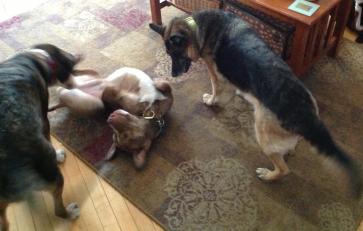
The whole point of our imperfect dog introductions is to (hopefully!) end up sharing the house with difficult dogs who may not have initially trusted each other. Each positive or neutral interaction between the dogs that has occurred in the previous steps has helped build up their confidence and trust in each other.
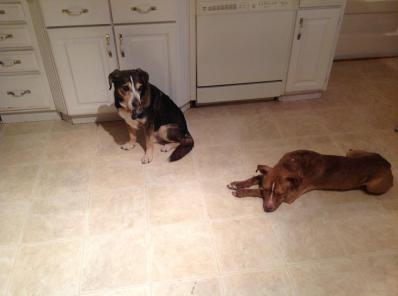
My favorite way get the dogs loose in the house together is right after a successful and super-boring yard introduction. I just walk inside the house and act like everything is normal. I will usually leave their leashes on as drag lines. I strive to make this portion as boring as possible and do what I can to avoid excitement and call dogs away before they can really start wrestling. I want the dogs to be bored (see photo above).
Just because they can be out in the house together does not mean that your job is done.
Always make sure food bowls and every single toy/ball/kong/bone is put up where the dogs can’t get it. Make sure that anything that could be perceived as ‘high value’ is inaccessible (out of sight and smell range). The note on smell is important–for some dogs, it’s enough to have food cooking on the stove to make them on-edge and potentially resource guard-y.
The other good reason to make sure food is put away is because having delicious smelling things can make a dog clump. With dogs that know each other or are more tolerant, getting close to a dog you don’t know that well might not be an issue. Below is a clump showing Frankie (tan dog) right after we got her and how she is feeling a little unsure about being in the middle of a ‘dog’ clump.
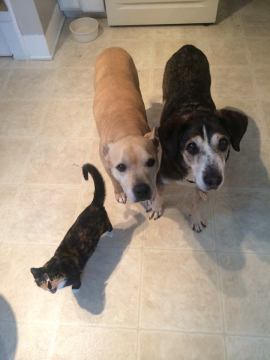
Throw in a nervous dog and something high value and it can be a recipe for disaster. I actively manage dogs so that dog clumps don’t exist for about 3 days. Avoid the dog clump! Three examples of dog clumps are below:
Dog clumps can put dogs that aren’t comfortable with each other into close proximity that can lead to fear aggression. Dog clumps with dogs that know and trust each other are typically not an issue and I don’t worry about them unless there is a specific reason to.
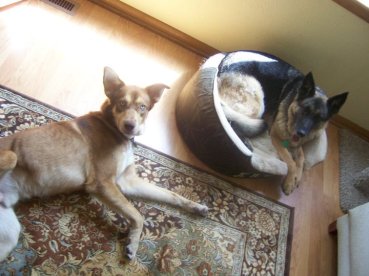
Other things to consider and keep an eye on when integrating dogs in the house are health and real estate.
Health is important because if a dog is uncomfortable or painful, they are more likely to act aggressively. The most frequent problems are usually associated with one dog climbing or stepping on an older dog with arthritis. Getting stepped on hurts and they may snark or bite. A negative/painful interaction early on in the house-integration process can lead to distrust that can’t be overcome. See Zoey and Lois’s story at the bottom of the page for an example.
Real estate means dog beds, couches, chairs, and human beds. Comfy places to relax can be sources of tension. I don’t usually remove them (or make them off limits) unless their is a dog that is a known space-guarder. But I do keep an eye on the dogs and call them away from one another while relaxing (usually with the “touch!” command) for the first couple of days to give them some time to acclimate and trust each other now that they can be up close and personal.
Try to:
- Call a dog away if they are approaching (or getting ready to climb on) a dog on a prime real estate (Keeping dogs from climbing on each other is especially important if either of the dogs has painful health issues like arthritis.)
- Avoid dog clumps
- Avoid delicious food preparation or eating for a little while (either that or separate them during that time)
- Pick up toys/food bowls before dogs are in the area
- Decide to hold off on social events held at your house. Don’t start integrating during stressful events like parties, home construction, or baby-sitting unruly children.

The picture above shows everything that is fine normally that is not okay with dogs that are just becoming used to each other. Can you find everything that would be wrong with this picture if it weren’t taken after the dogs were comfortable with one another?
- Food preparation
- Large number of people in a small space
- Chaos and movement
- Food bowl down
Regarding children, everything about difficult dog integration is harder with children, because their safety has to come first. You do not want them getting stuck in the middle of a dog-fight. They also pose other challenges depending upon how large they are, like dropping food, opening doors/baby gates, and potentially creating extra stress for the dogs.
During household integration, you can continue to use tie-downs occasionally and should ALWAYS continue to keep the dogs apart when there is no one home or supervising. For foster animals, we never allow them to be out with our personal animals when we aren’t home. For dogs that have integrated well and are ours, we will often decide to leave them alone together if we feel like we can trust them. Some people never leave animals out together without supervision. For us, it depends on the animals but often once we trust the dogs we will accept a small amount of risk to allow the dogs to provide companionship to each other.
Case Studies:

Above: A dog clump that is okay because these dogs know and trust each other. It took dog-selective Meja (the spotted dog on the left) a little over a month to become completely comfortable with Homer (middle) and Frankie (right). It took dog-social Homer and dog-tolerant Frankie less than a day to integrate (we did this via a group walk and a meeting in the backyard) and they were comfortable with each other in less than a week.
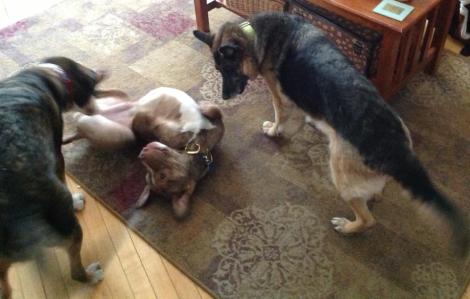
Above: Homer (L), reactive foster dog Matt (middle) and reactive dog Zoey (R). It took about 2.5 months for Matt to integrate into our household. Once Matt was integrated it was like he belonged and we never worried about having him out with our dogs. Matt did resource guard but we knew this before integrating and were able to remove his high-value items from our house so he never guarded with Homer and Zoey.

Above: After a (seemingly) successful and seamless integration of about a week, tan dog Lois (who was a confusing mix of dog-aggressive, dog-social, and dog-tolerant) and Zoey (dog-reactive) had the first (ever) dog fight at my house right after this picture was taken. They were pretty comfortable with each other and chose to lay as shown in the photo. So what happened?
Zoey was laying on the floor still, but Lois had gotten up. Lois walked up and was paying attention to something else, and stepped on Zoey. Zoey had arthritis and her hips were painful. Zoey leapt up and barked/growled at Lois—basically saying loudly that she needed space and did not appreciate being stepped on. That could have been the end of the interaction if Lois was the type of dog to back off with her hands up going “my bad!” but Lois isn’t that kind of dog. Lois interpreted Zoey’s response as an attack and responded immediately by biting Zoey’s leg. The fight would have gone on longer but I was right there with them to break it up.
Although we fostered Lois for 4 months after this incident and tried to repair their relationship (by creating space with exercise pens and tie downs, just like with an initial introduction), they remained distrustful and wary around one another.

Because their relationship failed to improve with work and time, we ended up moving Lois to another foster home.
Although we felt guilty and like we ‘failed’ Lois at the time, occasionally finding someplace else for a dog to live is the best option for the dog. It removes them from a stressful situation (you wouldn’t want to live with someone you can’t stand, would you?)
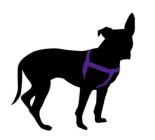



Wow!!! What an awesome, well thought-out guide. Really enjoyed reading these blog posts, very useful info.
LikeLike